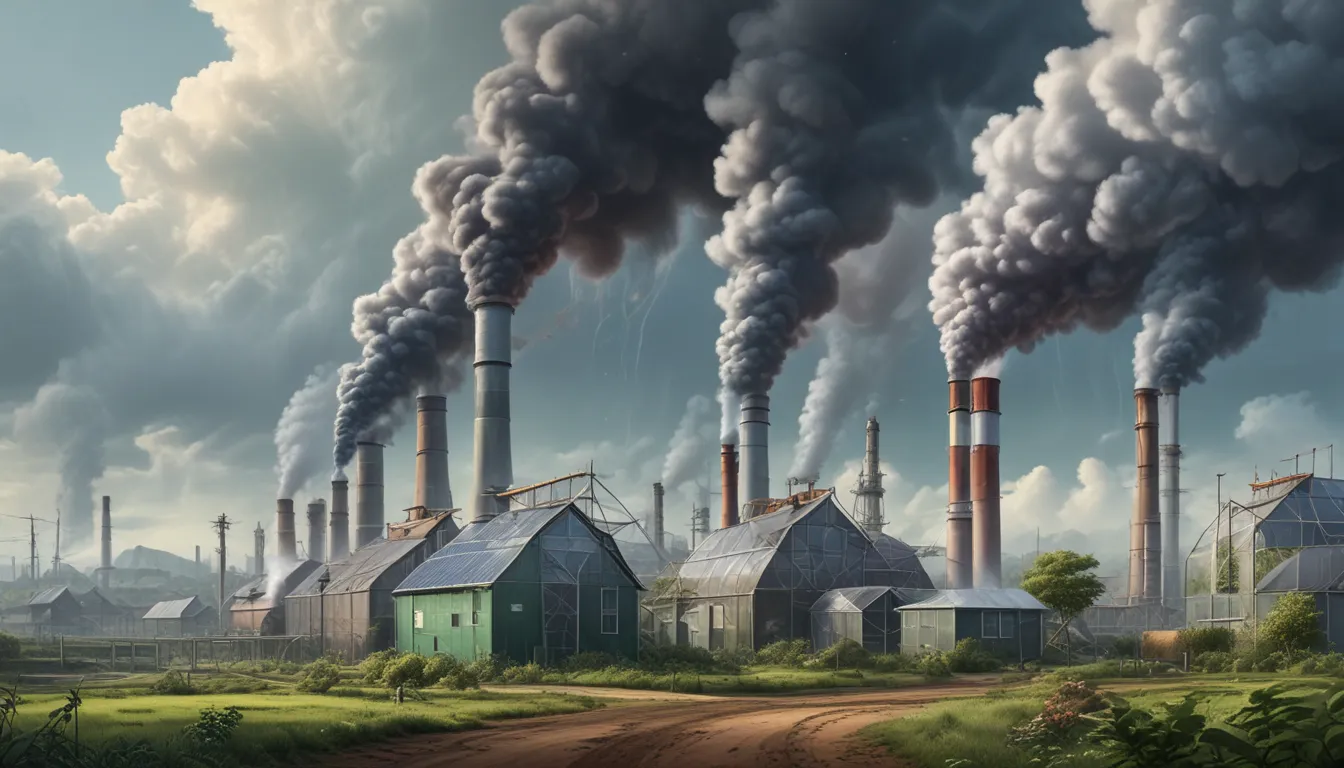A Note About Images: The images used in our articles are for illustration purposes only and may not exactly match the content. They are meant to engage readers, but the text should be relied upon for accurate information.
In the realm of environmental science, greenhouse gases are a significant topic of discussion. These gases have a critical function in regulating Earth’s temperature, but their excessive accumulation has resulted in the concerning phenomenon of global warming. In this article, we will delve into 18 intriguing facts about greenhouse gases, shedding light on their composition, sources, impact on climate change, and potential solutions. From exploring the natural greenhouse effect to understanding the anthropogenic activities that contribute to the rise in greenhouse gas emissions, we will embark on a journey to unravel the complexities of these gases and their implications for the planet. Join us as we uncover the science behind greenhouse gases and their profound influence on the delicate balance of Earth’s atmosphere.
Key Takeaways:
- Greenhouse gases, such as carbon dioxide and methane, play a crucial role in trapping heat and regulating Earth’s temperature.
- Human activities have significantly increased the levels of greenhouse gases, leading to global warming and climate change.
- International agreements like the Paris Agreement and Kyoto Protocol aim to reduce greenhouse gas emissions and combat climate change.
- Transitioning to renewable energy sources can help mitigate the impact of greenhouse gases on the environment.
Greenhouse Gases: A Crucial Aspect of Earth’s Climate System
Greenhouse gases are an essential component of Earth’s climate system, playing a vital role in maintaining the planet’s temperature. These gases trap heat in the atmosphere, contributing to the greenhouse effect. Here are 18 captivating facts about greenhouse gases that highlight their significance and impact on the environment.
Greenhouse Gases Are Essential for Sustaining Life on Earth
Greenhouse gases, including carbon dioxide, methane, and water vapor, form a natural insulation layer around the Earth that helps regulate the planet’s temperature. Without the greenhouse effect, the Earth’s average temperature would be significantly colder, making it uninhabitable for many forms of life.
The Concentration of Greenhouse Gases Has Increased Dramatically
Human activities, such as burning fossil fuels and deforestation, have led to a substantial increase in greenhouse gas concentrations in the atmosphere over the past century. This heightened concentration has amplified the greenhouse effect, resulting in global warming and climate change.
Carbon Dioxide Is the Most Prevalent Greenhouse Gas
Carbon dioxide is the most abundant greenhouse gas, released through natural processes like respiration and volcanic eruptions, as well as human activities such as burning fossil fuels and industrial processes.
Methane Is a Potent Greenhouse Gas
While less abundant than carbon dioxide, methane is a potent greenhouse gas with a significantly higher heat-trapping capability. It is released during the production and transport of coal, oil, and natural gas, as well as from livestock and agricultural practices.
Water Vapor Is the Most Abundant Greenhouse Gas
Water vapor is the most prevalent greenhouse gas in the atmosphere, primarily influenced by natural processes like evaporation and condensation. Human activities can indirectly affect water vapor levels through activities that alter the climate.
Greenhouse Gases Contribute to the Enhanced Greenhouse Effect
The excessive release of greenhouse gases into the atmosphere has intensified the greenhouse effect, resulting in a rise in global temperatures and subsequent climate changes. This phenomenon is known as the enhanced greenhouse effect.
The Kyoto Protocol Aims to Limit Greenhouse Gas Emissions
The Kyoto Protocol, an international treaty adopted in 1997, established binding obligations for industrialized countries to reduce their greenhouse gas emissions. It was designed to mitigate global warming and promote sustainable environmental practices.
Greenhouse Gas Emissions Are Linked to Human Activities
The majority of greenhouse gas emissions result directly from human activities, including burning fossil fuels for energy, industrial processes, transportation, and deforestation. These activities significantly contribute to increased levels of greenhouse gases in the atmosphere.
Deforestation Contributes to Greenhouse Gas Emissions
Deforestation, particularly in tropical regions, releases stored carbon into the atmosphere, contributing to elevated greenhouse gas concentrations. This process exacerbates the impact of human activities on the environment.
Greenhouse Gases Have Diverse Sources
Greenhouse gases originate from a variety of sources, including natural processes like volcanic eruptions, decomposition of organic matter, and animal digestion, as well as human activities such as agriculture, land use changes, and waste management.
The Ozone Layer and Greenhouse Gases Are Distinct Entities
While both the ozone layer and greenhouse gases are essential components of Earth’s atmosphere, they serve different functions. The ozone layer primarily shields the Earth from harmful ultraviolet radiation, while greenhouse gases regulate the planet’s temperature through the greenhouse effect.
Greenhouse Gas Emissions Vary Across Countries
Different countries exhibit varying levels of greenhouse gas emissions, influenced by economic activities, energy production methods, and environmental policies. This discrepancy underscores the importance of global cooperation in addressing climate change.
Greenhouse Gases Have Longevity in the Atmosphere
Greenhouse gases can persist in the atmosphere for varying durations, with some, like carbon dioxide, lasting for centuries. This prolonged presence contributes to the long-term impact of greenhouse gas emissions on Earth’s climate system.
The Impact of Greenhouse Gases Extends Beyond Climate Change
In addition to driving climate change, the accumulation of greenhouse gases can have far-reaching effects on ecosystems, agriculture, human health, and the frequency of extreme weather events. This highlights the multi-faceted implications of heightened greenhouse gas concentrations.
Greenhouse Gas Emissions Are Measured in Carbon Dioxide Equivalents
To facilitate comparisons of different greenhouse gases, emissions are often expressed in terms of carbon dioxide equivalents (CO2e), standardizing the global warming potential of gases based on their heat-trapping capabilities.
The Paris Agreement Aims to Combat Climate Change
The Paris Agreement, adopted in 2015, unites nations in efforts to limit global temperature rise and adapt to climate change impacts. It emphasizes reducing greenhouse gas emissions and mobilizing financial resources for sustainable development.
Greenhouse Gas Emissions Can Be Mitigated Through Renewable Energy
Transitioning to renewable energy sources like solar, wind, and hydroelectric power can substantially reduce greenhouse gas emissions, offering a sustainable alternative to fossil fuels and aiding in climate change mitigation.
Greenhouse gases play a pivotal role in shaping Earth’s climate and are intricately linked to human activities and environmental dynamics. Understanding the complexities of greenhouse gases and their impact is essential for devising effective strategies to mitigate climate change and safeguard the planet’s future.
Conclusion
In conclusion, greenhouse gases are crucial for regulating Earth’s temperature and maintaining a habitable environment for all living organisms. Recognizing the sources and effects of these gases is essential for reducing emissions and minimizing their impact on the planet. Through collective efforts and informed decision-making, we can work towards a more sustainable and balanced relationship with our environment.
FAQs
What are the main greenhouse gases?
The main greenhouse gases include carbon dioxide, methane, nitrous oxide, and fluorinated gases, trapping heat in the Earth’s atmosphere and contributing to the greenhouse effect.
How do greenhouse gases affect the climate?
Greenhouse gases trap heat in the Earth’s atmosphere, leading to global warming, changes in climate patterns, rising sea levels, and other environmental impacts known as the greenhouse effect.
By delving into the captivating world of greenhouse gases, we can deepen our understanding of their impact on our planet and work towards sustainable solutions for a healthier environment.






